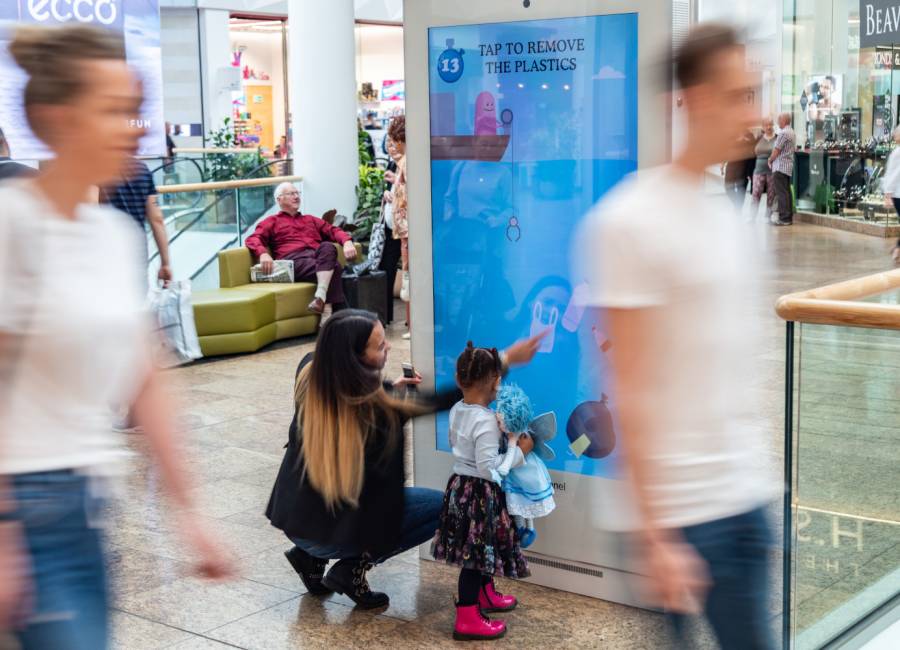Interactive Out of Home (OOH) advertising helps brands stand out from competitors and leave a lasting impact on audiences. But what exactly constitutes interactivity in Out of Home, and how can you use it to drive engagement? Let’s find out.
.jpg)
What is interactive OOH?
The idea of interactive OOH might be confusing. After all, viewing is a type of interaction, so isn’t all Out of Home advertising interactive?
In a sense, this is true. But the term ‘interactive OOH’ has a more specific meaning than that. When we talk about interactive OOH, we’re referring to viewers actively engaging with adverts.
The easiest way to picture this happening is with touchscreen displays, so it’s natural to immediately start thinking about interactive Digital Out of Home. But, in actuality, interaction can be woven into pretty much any OOH campaign, regardless of whether digital screens are used or not.
A lot of interactive OOH campaigns focus on a ‘trigger to change’ methodology. This could be a billboard with an integrated button that, when pressed, triggers lights to turn on. Or a digital screen where the displayed content changes in response to viewers posting a specific hashtag.
However, creatives can also be interactive without triggering any kind of change. For example, an interactive billboard could simply contain a tactile panel that invites the viewer to come closer and touch it.
Basically, as long as the audience is engaging with the advert outside of passive viewing, it’s interactive OOH.
Why interactive advertising is so powerful
The concept of interactive advertising isn’t unique to Out of Home. From social media polls to website chatbots, there are plenty of different ways in which brands use interactive marketing to connect with their customers.
The reason for its popularity is simple: interactive advertising is one of the most effective ways to drive high engagement. When brands use this technique, they leverage basic human psychology, tapping into the fundamental principle that communication works best when it’s two-way.
Some of the other things that make interactive advertising so powerful are:
Feedback and responsiveness:
Interactive elements provide immediate feedback to the user, reinforcing the value of their participation.
The psychology of anticipation:
Interactive experiences can create a sense of curiosity about what comes next, compelling viewers to continue interacting.
Gamification:
When interactive advertising incorporates elements of games or challenges, the incentive of ‘winning’ motivates the participant to spend more time engaging.
A sense of autonomy:
Allowing audiences to become active participants gives them a level of control that avoids the experience feeling too salesy.
Progressive disclosure:
Interactive adverts offer the opportunity to gradually reveal content in response to engagement, rather than overwhelming users with too much information at once.
At its core, interactive advertising works because of its audience-centric approach. By weaving together the viewer and the message, engagement is baked into the experience and the audience walks away having established a more personal connection with the brand.
Types of interactive OOH
Interactive OOH comes in many different forms, offering brands ultimate creativity when it comes to building campaigns that stand out and resonate.
Here are some of the most popular ways to make an Out of Home campaign interactive:

QR codes: low effort but high reward, QR codes improve interaction by serving as a bridge between the offline and online worlds.
Augmented reality (AR): OOH can be taken up a notch with AR ads, which superimpose digital elements onto the real world for an immersive and interactive experience.
Touchscreens: interactive OOH screens enable direction interaction with the display’s interface, offering unlimited opportunities for advertisers.
Sensory elements: scented panels and tactile surfaces are examples of how brands can build stronger connections with their audiences by engaging them through multiple senses.
Gesture recognition: inbuilt sensors detect and respond to viewers’ movements, creating a dynamic interactive experience.
Voice activation: interaction can be facilitated through voice commands, offering a more personal and intuitive experience for audiences.
Manual interaction: incorporating manual features like levers and buttons allows viewers to physically interact with adverts.
Product sampling: whether through bespoke vending machines or simply attaching goods to static advertising, brands can dispense products for audiences to engage with.
This list isn’t exhaustive – so if you have a unique idea for incorporating interactive elements into your OOH campaign, please get in touch to discuss how we can turn your concept into reality.
The benefits of using interactive OOH to drive engagement
Interactive ads encourage viewers to actively engage with content, leading to more meaningful interactions with brands. This offers several key benefits:
Brand recall: Interactive experiences are more memorable, standing out against the clutter of visual information that audiences take in every day.
Customer loyalty: By fostering a deeper connection with the audience, interactive OOH can increase customer loyalty.
Cohesive customer journeys: Interactive OOH can be used to seamlessly integrate online and offline experiences
Brand differentiation: Interactive OOH experiences showcase brands’ dedication to innovation and customer-centricity, setting them apart from competitors and building a positive brand perception.
Data collection and insights: Interactive OOH facilitates the collection of valuable first-party data. Additionally, interactive elements can be tracked and analysed to reveal insights about audience behaviour.
Interactive Out of Home advertising best practices
Before you can craft meaningful connections and drive deeper engagement from your audience, adhering to interactive OOH best practices is fundamental.
Putting together a compelling creative is the first port of call. In order for your audience to engage with your ad, they have to notice it in the first place. Fortunately, 81% of respondents to a Content Marketing Institute (CMI) survey agreed that interactive content grabs attention more effectively than static content, making the job a whole lot easier.
Interactive features should be user-friendly, especially in the case of digital formats which can be harder to navigate intuitively. And a clear CTA is imperative for getting audiences to take the first step in the interaction.
Making use of personalisation and user-generated content can really help to maximise engagement and reach, but be careful not to overcomplicate as it can put users off.
Finally, don’t forget your goals! As great as audiences engaging with your brand in any form might be, what do you actually want from the interaction? Make sure that your creative aligns with the campaign’s purpose in order to fully reap the rewards of this exciting medium.
For more information on the capabilities of interactive OOH or to get planning your campaign today, please contact our expert team.
Start your OOH campaign today
Interested in learning more about OOH advertising? Fill in our form and one of our team will be in contact shortly to answer your questions and get started on your next campaign.




